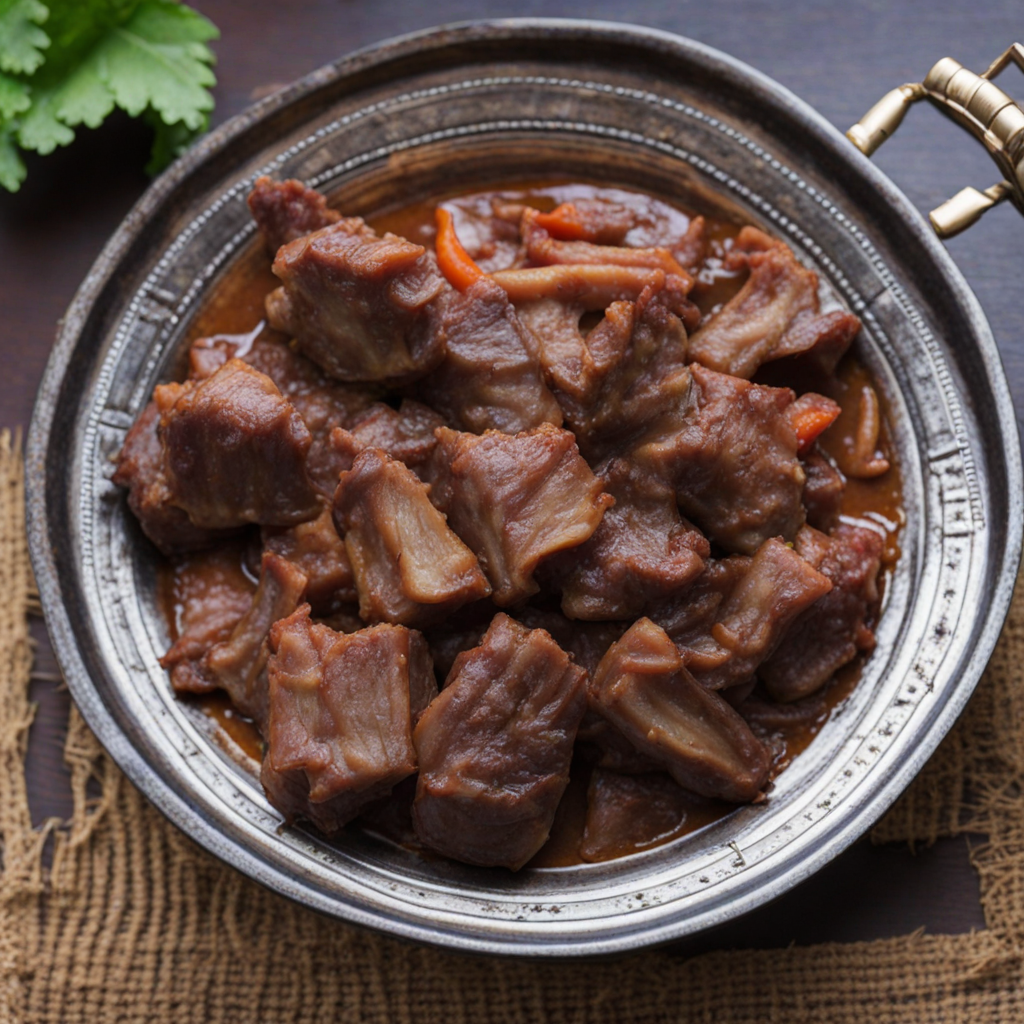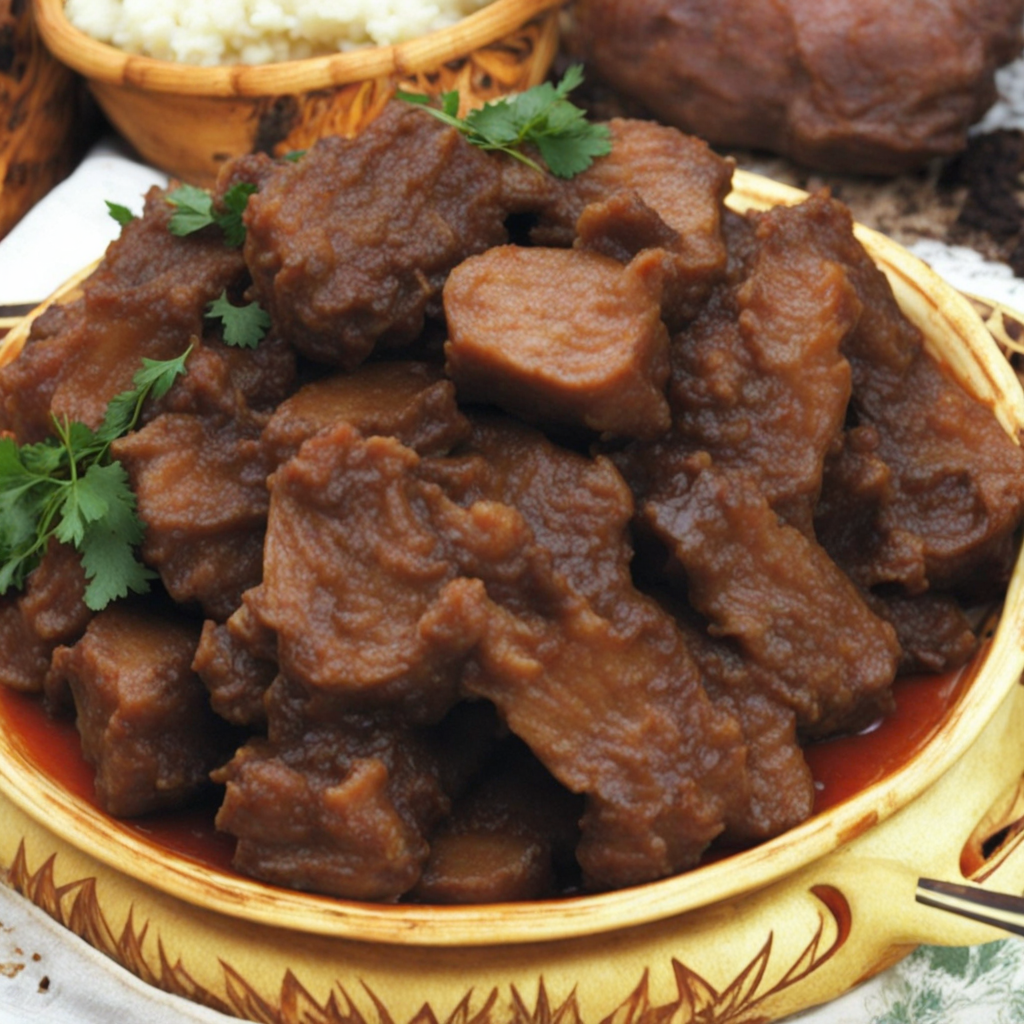Inyama y'ihene
Inyama y'ihene, a traditional Rwandan dish, features tender goat meat that is often marinated and then slow-cooked to enhance its rich flavors. The preparation typically includes a blend of local spices, garlic, and onions, which infuse the meat with a savory depth. The goat is often grilled or simmered in a pot, allowing it to absorb the aromatic seasonings fully, resulting in a succulent and juicy dish that melts in your mouth. This preparation method brings out the natural sweetness of the meat, making it a beloved choice among locals and visitors alike. Accompanying Inyama y'ihene are various side dishes that complement its robust flavor profile. Common accompaniments include isombe, a dish made from cassava leaves, and ugali, a staple starch made from maize flour. The combination of these sides adds texture and a touch of earthiness to the meal, balancing the richness of the goat. Additionally, fresh vegetables such as avocado and tomatoes often accompany the dish, providing a refreshing contrast that enhances the overall dining experience. Inyama y'ihene is more than just a meal; it represents a cultural connection to Rwandan heritage and community. Often enjoyed during special occasions or family gatherings, the dish brings people together, inviting them to savor not only the flavors but also the stories and traditions behind it. For anyone looking to explore new tastes, Inyama y'ihene stands out as a delicious introduction to the vibrant and diverse culinary landscape of Rwanda.
How It Became This Dish
Inyama y'ihene: A Culinary Journey Through Rwandan Heritage Introduction Inyama y'ihene, which translates to "goat meat" in Kinyarwanda, is a beloved dish that holds a significant place in Rwandan culture and cuisine. This dish is not only a staple in daily meals but also plays an important role in various cultural and social gatherings. Exploring the history of inyama y'ihene unveils a rich tapestry of tradition, community, and the evolving landscape of Rwandan food practices. Origins of Inyama y'ihene The origins of goat farming in Rwanda can be traced back to the early inhabitants of the region, who domesticated goats for their meat, milk, and hides. The mountainous terrain and lush pastures of Rwanda provided an ideal environment for goats to thrive, making them an integral part of the agricultural landscape. Goats were often seen as a symbol of wealth and status, and families would raise them for both sustenance and trade. The practice of consuming goat meat is deeply rooted in the traditional diets of Rwandan communities. Historically, goat meat was reserved for special occasions and celebrations due to its association with prosperity and communal gatherings. It was common for families to slaughter goats during significant events such as weddings, births, and religious ceremonies, signifying the importance of sharing a meal with loved ones and the community. Cultural Significance In Rwandan culture, inyama y'ihene is more than just a dish; it is a symbol of hospitality and unity. The preparation and sharing of goat meat bring people together, fostering social bonds and reinforcing community ties. It is often served during communal feasts, where families and friends gather to celebrate milestones or simply enjoy each other's company. The act of sharing a meal is deeply ingrained in Rwandan society, reflecting values of generosity and togetherness. The preparation of inyama y'ihene also highlights traditional cooking methods that have been passed down through generations. Goat meat is typically marinated in a blend of local spices, herbs, and sometimes even fermented sorghum to enhance its flavor. It is then roasted, grilled, or stewed, often accompanied by staple Rwandan side dishes such as ugali (a maize porridge) or isombe (cassava leaves). The communal aspect of cooking and sharing these meals reinforces cultural traditions, as recipes are often handed down through families, preserving the culinary heritage of the Rwandan people. Development Over Time As Rwanda has evolved, so too has the preparation and consumption of inyama y'ihene. The 1994 Rwandan Genocide had a profound impact on the country, leading to significant changes in social structures, economic systems, and cultural practices. In the aftermath, the rebuilding of communities also involved a revival of culinary traditions, with a renewed emphasis on local ingredients and traditional dishes like inyama y'ihene. In the decades following the genocide, there has been a growing interest in Rwandan cuisine both within the country and internationally. This resurgence has led to a greater appreciation for traditional foods, and chefs are now incorporating modern techniques while still honoring the authenticity of dishes like inyama y'ihene. Restaurants across Rwanda now feature goat meat dishes that blend traditional recipes with contemporary culinary styles, introducing new generations to the flavors of their heritage. Moreover, goat farming has become increasingly important to Rwanda's economy, with initiatives aimed at promoting sustainable agricultural practices. Farmers are encouraged to raise goats not only for household consumption but also for sale in local markets, providing a source of income and supporting food security. This focus on local farming has helped cement the place of inyama y'ihene in the contemporary Rwandan diet, ensuring that it remains accessible to all. Regional Variations and Modern Interpretations While inyama y'ihene is enjoyed throughout Rwanda, regional variations exist that reflect local tastes and available ingredients. In some areas, goat meat may be cooked with tomatoes and onions for a rich stew, while in others, it is grilled over open flames, accentuating its smoky flavor. These regional interpretations showcase the diversity of Rwandan cuisine and demonstrate how local customs influence food preparation. In urban areas, particularly in Kigali, the capital city, the popularity of inyama y'ihene has soared. Restaurants and street vendors serve it in a variety of styles, catering to both locals and tourists. The dish has also gained prominence at social events, with goat meat barbecues becoming a popular choice for gatherings, celebrations, and festivals. This evolution reflects a broader trend in Rwanda, where traditional foods are celebrated and adapted to fit contemporary lifestyles. Conclusion Inyama y'ihene is more than just goat meat; it is a reflection of Rwandan identity, history, and culture. From its origins in the highlands of Rwanda to its place in modern dining, this dish encapsulates the resilience of a nation that has embraced its culinary heritage while adapting to change. As Rwandans continue to gather around the table to share meals of inyama y'ihene, they are not only preserving their traditions but also celebrating the bonds that unite them as a community. In a world that often feels disconnected, the shared experience of enjoying inyama y'ihene serves as a reminder of the power of food to bring people together. As Rwanda continues to grow and evolve, the humble goat remains a symbol of prosperity, unity, and the enduring legacy of rich culinary traditions that define this beautiful country.
You may like
Discover local flavors from Rwanda







